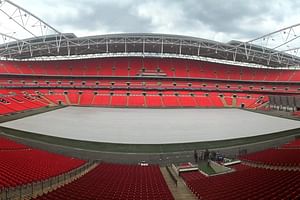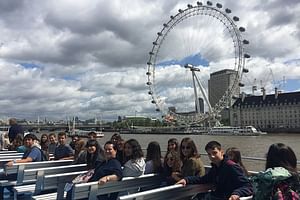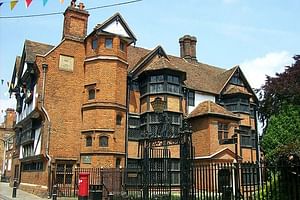-
Day 1
Travelling to Cardiff and Cardiff City Tour
Travelling to Cardiff and Cardiff City Tour
-
Day 1
Today’s journey goes straight to the Capital of Wales, Cardiff which takes approximately three and a half hours by car. The roots of its name are debated, but it is widely believed that the original...
Today’s journey goes straight to the Capital of Wales, Cardiff which takes approximately three and a half hours by car. The roots of its name are debated, but it is widely believed that the original Welsh title Caer-Taff (Fort on the Taff) originated from the English corruption. In the 1st century AD, in Roman times, a little fortification was built, where the Gloucester-Carmarthen road crossed the Taff several times before the present stone-closed site was created. With the arrival of Normans in the 11th century, the city began its continuing existence. Within the remnants of the Roman fort, possibly already in 1081, the Norman landowner Robert Fitzhamon built a fortification. The Castle of Cardiff was the foundation of Glamorgan lords who for the next 450 years ruled over the County in the name of the English Crown. Cardiff, with many things to see, is a fantastic place to visit. Your sightseeing tour will also include other highlights such as the National Museum of Wales, Norwegian Church, Cardiff Bay and The Principality Stadium in the city. Let's start right away.
-
Day 1
The Castle of Cardiff is one of the most significant Welsh heritage sites and an internationally important site. The walls and fairy tale towers of Cardiff Castle are situated in the centre of the cit...
The Castle of Cardiff is one of the most significant Welsh heritage sites and an internationally important site. The walls and fairy tale towers of Cardiff Castle are situated in the centre of the city's beautiful parks. By the end of 50AD, the Roman fort at Cardiff was built on a strategic site with easy access to the sea. Archaeological findings indicate that the Cardiff Castle was the first of four forts to occupy this site, all of them of various sizes. Remains can now be seen from the Roman wall. The castle keep was built after the Norman invasion and the Roman fort site was restored. The first motte was possibly made of wood and was designed by Robert Fitzhamon, Norman Lord of Gloucester. Through the years there came more mediaeval fortifications and buildings. Our guide will also reveal the role of the Bute Family in 1800s and also William Burges who was an architect and a designer who totally remodelled the castle in a Gothic revival style, lavishing money and attention on the main range. The resulting interior designs are considered to be amongst "the most magnificent that the gothic revival ever achieved" in Britain.
-
Day 1
The National Museum of Cardiff houses amazing national history, geology, and natural heritage collections, and a large number of temporary exhibits, right at the heart of Cardiff's elegant city centre...
The National Museum of Cardiff houses amazing national history, geology, and natural heritage collections, and a large number of temporary exhibits, right at the heart of Cardiff's elegant city centre. The museum's art collection is one of the best in Europe. Visitors can see 500 years of beautiful Welsh and worldwide paintings, sketches, sculptures, silver and pottery, including one of the best collection of Surrealist art in Europe. Here in this museum, you may take a wonderful ride through Wales' evolution from the very early days to the present day. The story begins from the big bang in the universe and takes you on a journey of 4,600 million years that brings the dinosaurs and woolly mammals along the way. You will also find out how life in Wales developed and what dinosaurs were straying around the country. Wales' rich natural past is a massive journey from the sea to the mountains. Here you can experience some of the unique environments that make Wales home to over 900 Sites of Special Scientific Interest. The Clore Discovery Centre is an enticing centre to explore museum objects like insects, fossils, and weapons of Bronze Ages, welcoming you to catch any of the 7.5 million objects that are usually hidden in their stores.
-
Day 1
One of the best landmark buildings in Cardiff Bay, the Norwegian Church Arts Centre provides amazing panoramic views of the seafront. The famous building was formerly a church of Norwegian sailors bef...
One of the best landmark buildings in Cardiff Bay, the Norwegian Church Arts Centre provides amazing panoramic views of the seafront. The famous building was formerly a church of Norwegian sailors before Cardiff Docks became the world's largest coal exporter, dating back to the industrial revolution. The Norwegian Church in Cardiff Bay is actually a small building which has a great past behind its doors. It was also the Church that hosted famous British novelist Roald Dahl's baptism, once a significant landmark and meeting point for the Norwegian naval people during the Industrial Revolution. During the industrial revolution, Norwegian seamen were familiar in Cardiff and many of those chose to settle for their shipping businesses, including Dahl's father Harald. In particular, during the second world war when Norwegian seamen couldn't return to their occupied homeland, so the Norwegian Church was a home away from home for all those sailors. Therefore, as the natural successor to the former congregation, the Norwegian society was founded and includes members from Cardiff, Swansea, Norway and beyond.
-
Day 1
The Millennium Stadium, known since 2016 for sponsoring purposes as the Principality Stadium is Cardiff's National Stadium in Wales. It is home to the national Rugby Union in Wales and has also hosted...
The Millennium Stadium, known since 2016 for sponsoring purposes as the Principality Stadium is Cardiff's National Stadium in Wales. It is home to the national Rugby Union in Wales and has also hosted national soccer team games in Wales. Initially planned to host the 1999 Rugby World Cup, it hosted several other major events too. The events include Tsunami Relief Cardiff concert, the Super Special Stage of Wales Rally Great Britain, the Speedway Grand Prix of Great Britain and numerous concerts. It also hosted six FA Cup finals and several other high-profile football fixtures while Wembley Stadium was being redeveloped. Millennium Stadium is the third-largest in the Six-Nation Championships after the Stade de France and London’s Twickenham Stadium. It is also the world's second-largest stadium with a completely retractable roof. This was Europe's second stadium to do so. The UEFA stadium was designated as a category four stadium and on 3 June 2017, it was announced as the venue for the UEFA champions' final 2017. The Welsh Rugby Union announced a 10-year sponsorship deal with the Principality Building Society. The stadium has been dubbed "Principality Stadium" since the beginning of 2016 and has a total of 73.931 seat capacity.
-
Day 1
The Industrial Revolution of the 1790s, which spurred mining in South Wales' valleys, is the origin for Cardiff's history. The Glamorganshire Canal was also built in 1794, which carried down iron and ...
The Industrial Revolution of the 1790s, which spurred mining in South Wales' valleys, is the origin for Cardiff's history. The Glamorganshire Canal was also built in 1794, which carried down iron and coal from the valley. With the growth of the industry, it became clear that a more efficient transport was needed and the Taff Vale Railway was opened in 1840. The increasingly growing trade in iron and coal was also the reason for many docks in the Victorian era. Butetown and the surrounding dockland have during this period become a cosmopolitan city of seafarers from around the world who made Cardiff their home. In the 1880s Cardiff had been the largest city in Wales, and its harbour handled more coal than any other harbour in the country. Coal shipments hit a record of 13 million tonnes on the eve of the First World War in 1913. At this point in the construction of the Coal Exchange, the global price of coal had reached their peak too, and here in Cardiff Bay, the world’s first £1 million deal was signed. However, demand for coal plummeted after the Second World War, as other countries were establishing their steel industries, foreign markets were lost. Trade-in container ports were declining and coal exports almost stopped in the 1960s. East Moors Steelwork ended in 1978 with the loss in South Cardiff of 3,200 jobs. By the beginning of the 1980’s, Cardiff Bay was a wasteland of abandoned docks and dock warehouses. Therefore, the history of Cardiff Bay is very much alike to London's Dockland. The Cardiff Docklands area is known today as Cardiff Bay and has been converted into a large freshwater lake by the Cardiff Barrage, which combines the Rivers Taff and the Ely. There are some other important sights such as the Techniquest Science Discovery Centre, Craft in the Bay, the Welsh Assembly at Pierhead, Butetown History and Arts Centre, the Norwegian Church Arts and the Wales Millennium Centre. The Red Dragon Centre provides unique entertainment opportunities for family fun in the heart of the city. Whether you want to have a bite to eat in one of Cardiff's many restaurants or go to the shops to make your trip a memorable one, you will have plenty of time. There are many beautiful shops and beach shops, go and indulge yourself in the capital. Overnight stay in the centre of town or near Cardiff Bay.
-
Day 1
Tonight, your accommodation will be provided in one of the 4-star hotels in Cardiff City Centre.
Tonight, your accommodation will be provided in one of the 4-star hotels in Cardiff City Centre.
-
Day 2
Full Day Brecon Beacons National Park - Aberfan Memorial and back to London
Full Day Brecon Beacons National Park - Aberfan Memorial and back to London
-
Day 2
Wales has been recently voted by the people as the 10th most beautiful country in the world. Together with England at number seven and Scotland, the UK is well known all over the world for its diverse...
Wales has been recently voted by the people as the 10th most beautiful country in the world. Together with England at number seven and Scotland, the UK is well known all over the world for its diverse beauty. If you're wondering why Wales was in the top ten, today you will find out how wonderfully beautiful this small country is. A whole day tour that leaves Cardiff and takes as many of the must-see places of interests in one day as possible including heart-rending Aberfan. We will start our tour with outstanding Brecon Beacons National Park, where you can experience some of the big sky landscape and hidden history. Walkthrough a merry-go-round wooden gorge to a beautiful waterfall and visit one of Wales' most popular beaches, it is a day of natural beauty.
-
Day 2
Aberfan has a tragic story. Life stopped at 9:13 am on the morning of October 21, 1966. It was a normal October day for a small mining village, where it had been raining for what seemed like forever. ...
Aberfan has a tragic story. Life stopped at 9:13 am on the morning of October 21, 1966. It was a normal October day for a small mining village, where it had been raining for what seemed like forever. That morning a waste tip from a nearby colliery slid down the mountainside into the village. The mud-slide raced down a steep hill sucking everything in its path into the chaos: landscape, buildings, and an entire schoolhouse. The mud-slide was coal waste that had slid down a rain-saturated mountainside. 140,000 cubic yards of black slurry cascaded down the hill above Aberfan. It destroyed everything it touched, eventually, it engulfed Pantglas Junior School and 19 houses. 144 people were killed. 116 of them were children. Most of the children sitting in their school classrooms. The Aberfan disaster wiped out a generation of Welsh school children and devastated the nation and told us tragic stories beneath the coal debris. Teacher David Beynon, 47, was found in the wreckage of the school cradling five of his pupils. They were dead in his arms. The tragedy in Aberfan would become one of the United Kingdom’s worst mining disasters—and it was completely avoidable. Today we will commemorate the people who lost their lives at the Aberfan Disaster Memorial. We will talk and discuss how the mine disaster became Elizabeth II's biggest regret. Could the disaster have been prevented? Who was responsible for this disaster? How did this disaster affect the Queen’s stoic character? What was the request of Princess Margaret (The sister of Queen Elizabeth II) from the nation? What was the message on the card that 3-year-old Karen Jones gave the Queen? Many questions will find their answers during our visit to this village of grief for today. During our tragic tour, we will see the trace of Queen’s continued efforts for the commemoration of this disaster such as tracking Aberfan Community Centre and the tree that Her Majesty planted in the Garden of Remembrance.





























